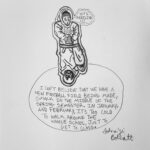This is the third and final piece of my Black History Month series, and there is no better way to end it than to introduce an antagonist turned anti-hero of black history named George Wallace.
The former Alabama governor was born on Aug. 25, 1919 in Barbour County, Alabama, to a farmer and his wife.
Although he was heavily into boxing as teenager, he took up a position as a legislative page at the state Capitol in Montgomery, making it an early goal to become the governor of Alabama one day.
He attended the University of Alabama school of Law and graduated with his law degree in 1942, and got married a year later.
Before entering politics, he entered the Army Air Corps during World War II and did some bombing missions in Japan, but was discharged shortly after.
When he returned to Alabama in 1953, he was elected as judge for the third Judicial Circuit Court of Alabama, a position he held for five years. Finally, he would run for governor, making sure to bill himself as a “moderate” despite being formerly known as a “dangerous liberal.”
His opponent, John Patterson, promoted segregation, anti-black policies, and was backed by the Ku Klux Klan. Wallace himself was backed by the NAACP, and would lost the primaries by a landslide.
What Wallace took from this experience was that he had to have an aggressive stance on race relations in order to advance his position. “I was out-niggered, and I will never be out-niggered again,” Wallace was quoted saying to his finance director after the loss.
With a fresh platform of pro-segregation plus the backing of the Klu Klux Klan, he ran again in 1962 and finally won. This is when he gave his famous inaugural speech of “Segregation now, tomorrow, and forever.”
During this time, he actively prevented Vivian Malone and James Hood, two black students, from enrolling at the University of Alabama with a sit-in until the national guard got involved.
The most well-known actions of the Alabama governor was his opposition to the Selma-to-Montgomery civil rights marchers. He ordered troops to stop the protesters, but it only led to violent confrontations that people observed from around the world.
This would greatly affect his public appeal, as he wished to eventually run for president and did so multiple times, all unsuccessful. As the 1970’s wore on, Wallace would could sense that attitudes were slowly changing and he began to ease up on his views of segregation.
In one of his last few attempts for a presidential bid, he ran as a Democrat. In 1972, he was shot by a mentally disturbed man named Arthur Bremer while campaigning in Maryland, leaving Wallace paralyzed from the waist down.
In his four terms as governor, Wallace had an enormous effect on the state he served. In 1982, he met with black congregations and even the Southern Christian Leadership Conference.
Wallace begged for forgiveness for the policies and stances he took in the prime of his career. Before dying of heart failure in 1998, he managed to win support from black organizations and improve economy, healthcare and infrastructure.














